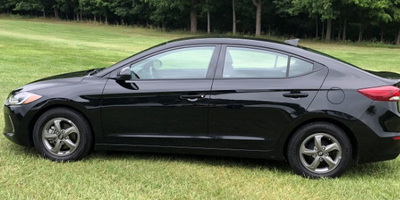A week spent in the hatchback version of Hyundai's swoopy compact
Pros:
Versatility
Exterior styling
Interior quality and design
Cons:
Suspension response over rough surfaces
Steering feel
The Korean invasion
For a nameplate that consisted largely of throwaway cars as recently as ten years ago, Hyundai has been keeping some pretty heady company as of late.
Despite its recent issues with EPA fuel economy figures, Korean auto manufacturer Hyundai remains on a roll here in the U.S. Retail sales in 2012 were up 9 percent versus 2011 and both its Sonata and Elantra models topped the 200,000 sales mark with both finishing in the Top 10 in car retail sales.
Speaking of the Elantra, just like the sedan there is much to like and a couple of things that I didn't particularly care for when it comes to the hatchback GT version. First, here are some basic facts along with the good news.
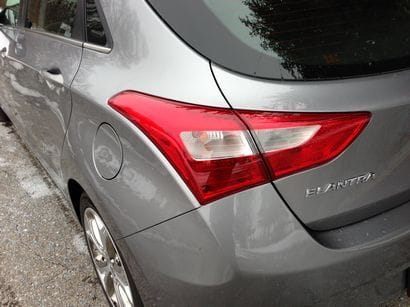
Trim level
The 2013 Hyundai Elantra GT is available in just one trim level with either a six-speed manual or optional six-speed automatic transmission. Also keeping things simple is the availability of just one engine – Hyundai's 1.8-liter Nu inline-4. The same one found in every Elantra, it features an aluminum block and head, dual continuously variable valve timing and a variable induction system; it develops 148 horsepower and 131 lb.-ft. of torque.
Standard safety features include stability and traction control, 4-wheel disc brakes with brake assist, ABS and EBD and six airbags.

Equipment highlights include power windows, locks and heated mirrors as well as remote keyless entry. Air conditioning, an audio system with CD, satellite radio with USB and audio input jacks are also standard. Steering wheel-mounted cruise control is also standard.
Also standard on the GT is Hyundai's Driver Selectable Steering Mode. The system consists of three modes: Comfort, Normal and Sport. The Comfort setting offers the highest degree of power assistance for city and parking environments, Sport offers the lowest level for higher-speed highway driving while the Normal setting is for mixed driving.
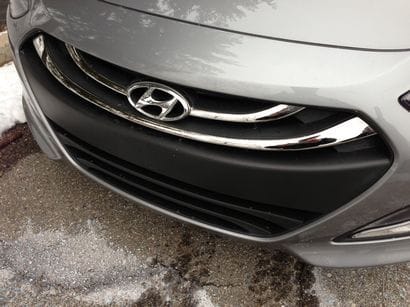
In addition to adjusting the power assistance levels in each mode, the system also adjusts on-center build-up feel and steering build-up curves throughout the steering range.
The GT also benefits from modifications to the basic Elantra suspension that include higher rear spring rates and Sachs dampers for improved chassis dynamics.
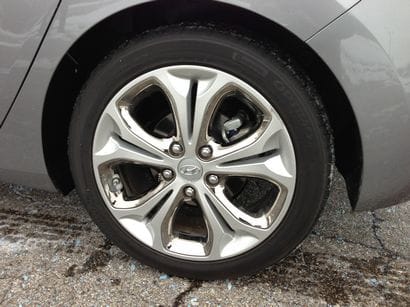
Our Titanium Gray metallic GT was equipped with the optional style package, which adds 17-inch alloy wheels, an even sportier suspension calibration, panoramic sunroof, turn signals integrated into the side mirrors, leather seats, steering wheel and shift knob, power driver's seat, aluminum pedals and power windows with a driver's-side auto up feature.
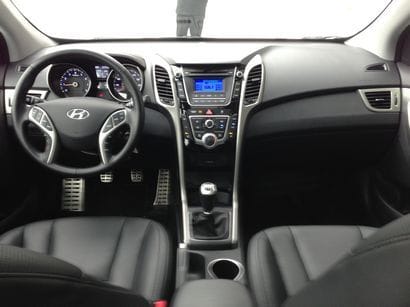
Interior
Interior fit and finish as well as the quality of materials is what we've come to expect from Hyundai – that is to say, world-class for the segment. Throughout the cabin, tasteful shades of gray and black soft-touch surfaces contrasted with brushed silver bright work.

All controls worked smoothly and were within easy reach of the driver. Steering wheel-mounted controls for the audio system, cruise control, Bluetooth hands-free phone system and driver information center were both easily understood and intuitive. And while this is something that should be expected, this isn't always the case when you consider that many manufacturers, in their quest to cram as much technology as possible into a vehicle, only end up confusing drivers with myriad touch screens and counter-intuitive selector knobs.
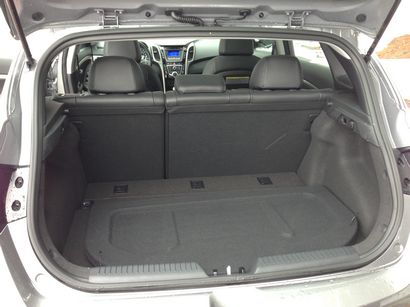
But I digress. Getting back to the Elantra GT, the headlight and turn signal stalk to the left of the steering wheel features a tap/flash to pass feature, while the right stalk controls the wiper functions.
The center stack, like the rest of the interior and control functions, is both stylish and easily understood. Buttons that flank the left and right of the touch screen control the navigation and media functions. Below the screen, a second set of controls handles the radio/CD functions as well as the navigation options.

Finally, below that and in another surround are another set of buttons and knobs that control the HVAC system.

Exterior
The exterior, although not as striking as either the coupe or sedan, still manages to encompass the company's “Fluidic Sculpture” design language while incorporating the square-ish and more versatile lines of a hatchback. Like all Hyundais, this begins with the brand's signature trapezoidal grille.
Just as in the sedan, beginning at that grille large headlamp enclosures sweep up over the flared front wheel well openings, while a prominent body crease begins at the leading edge of the front door and sweeps back, ending at the lower corner of the rear taillamp lens.

The cab-forward greenhouse features a steeply-raked windshield with the roofline peaking at the B-pillar, where it gradually begins to slope back to the rear hatch window where the roofline meets the rather aggressive-looking upper rear spoiler
Aside from its styling, other changes that differentiate the hatchback from either the sedan or the coupe encompass the very reasons I prefer the GT's body style: it's both smaller on the outside and bigger on the inside than its siblings.

These changes include a decrease in overall length of nine inches and a wheelbase that's two inches shorter. The GT's width is just 0.2 inches wider and its overall height is 1.4 inches taller. Both its front and rear track are also slightly narrower (by 0.5 in both front and rear).
But despite the fact that it's three quarters of a foot shorter, passenger interior volume is up by a half cubic foot (96.1 versus 95.6 cubic feet) and interior cargo volume is up a whopping 8.2 cubic feet (from 14.8 to 23 cubic feet).
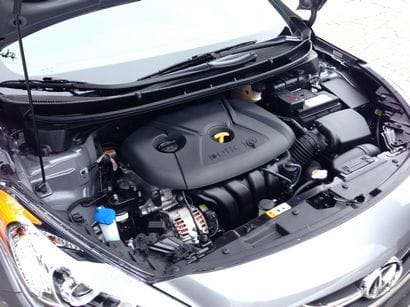
On the road
Like the sedan, rear seat passengers never complained of a lack of headroom and, in fact, were quick to comment that the rear seats, especially for a compact, were very comfortable.
Unlike the complaints the company has received from some consumers, I found its fuel economy to be exemplary. Around town I averaged nearly 28 miles per gallon, while freeway cruising at posted speeds resulted in an observed 39.2 mpg.

That, then, is the good news and there is plenty of it. But like just about every other small, affordable compact, there are a few things that could be improved upon.
Like the sedan, on freeways the Elantra's suspension easily soaked up small bumps. But also like the sedan, larger ones or a series of pavement irregularities can occasionally upset its rear torsion axle suspension.
In around town driving the GT is also up to the task of handling smaller bumps with aplomb. But like its sedan counterpart, the larger ones including road imperfections and the ever-present Michigan potholes can sometimes affect its composure.

Aside from that, I do have one other nit to pick with the GT although it's not as serious as the one I had with the sedan.
Electric steering, as I've stated previously, has to be fine tuned in order to give the right amount of feedback. Like all Hyundai sedans that I've driven there was a nice weight to the steering in highway driving. Unlike the Elantra sedan, the selectable steering system on the GT lessened the weight in urban driving resulting in much better feedback at lower speeds. However, the system still retains some on-center numbness in both Sport and Normal modes.

Pricing
New car pricing for the 2013 Elantra GT is set at $18,395 when equipped with a manual transmission. Opting for the 6-speed automatic, certainly the benchmark for this segment, will tack on an additional $1,000.
Three option packages are offered. The Style Package, which this one came with, adds $2,750 to the base price. The Touch & Go Package, at $950, gives you everything in the Style Package less the leather seats and panoramic sunroof.
Finally, the Tech Package, which also requires that you select the Style Package, is priced at $2,350 and includes a nav system, rearview camera, automatic headlights and dual-zone automatic climate control.
Our GT, in addition to the Style Package, also included carpeted floor mats at $95 which, when combined with the $775 freight and handling charges brought its total price to $22,015.

The Bottom Line
So what does this all mean?
The 2011 Elantra finally brought Hyundai into serious contention with the Cruze, Focus, Civic, Corolla and Jetta – all vehicles vying for attention in what has come to be a hotly-contested market segment.
The 2013 Elantra GT will give the lineup an even more versatile model that's aimed squarely at drivers wishing for a sportier handling version. It also shows that the Elantra can hold its own with all but the most sporting models in the compact class.
Now if only Hyundai could find a way to cross an Elantra GT with, say, a Genesis Coupe they might even end up with a Focus ST fighter on their hands. We can only hope.








